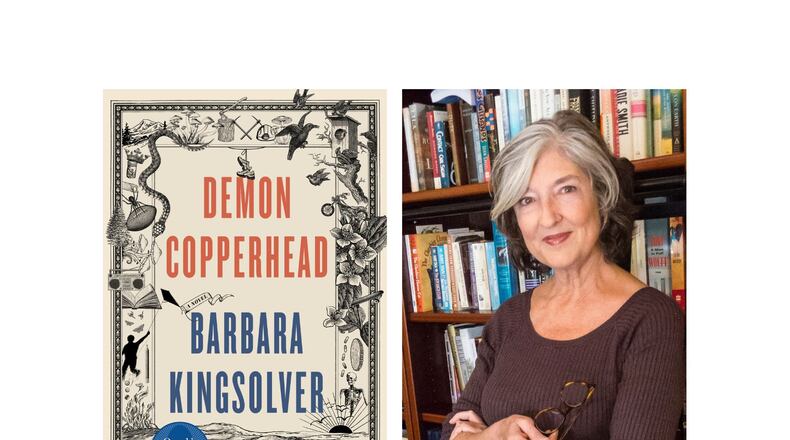Barbara Kingsolver has a lot to say about Appalachia. About the heart and soul of the people who populate her homeland. About the “hillbilly” stereotype proliferating popular culture. About the opioid epidemic that has left an entire generation of children coming up without parents. Harnessing the narrative voice of Charles Dickins in “David Copperfield” — a Victorian exploration of institutional poverty and cruelty as experienced through the eyes of an orphan child — Kingsolver’s “Demon Copperhead” is a heartrending, probing and ultimately hopeful tale about a young boy’s journey from devastation to survival in modern-day Lee County, Virginia.
“First, I got myself born,” Demon Copperhead says in the opening line of his titular tale. And it was no easy feat. Birthed to a junkie passed out on the bathroom floor of her single-wide trailer, he punches his way out of the amniotic sac and keeps swinging as life throws him blows. His 18-year-old mother is a graduate of the foster system and without a family. His dad, the source of his nickname and “the dark skin and light-green eyes of a Melungeon” died before Demon was born. (Melungeon are a tri-racial ethnic group known as the “Lost Tribe of Appalachia.”)
Thankfully, the stalwart Peggot family live next door and have a long history of looking out for kids in need. They keep an eye on young Demon as his mom vacillates between rehab and sobriety. Although she can’t provide extras, her ability to keep a job — and Demon’s daily commitment to waking her up for work — allow them to get by. As Kingsolver pours cement into the foundation of Demon’s formative years, his indomitable spirit emerges in a region where “everything that could be taken is gone. Mountains left with their heads blown off, rivers running black…”
Demon is a razor-sharp and likeable Holden Caulfield, a “Catcher in the Rye” possessing a resilience in the face of hardship that’s impossible not to admire. And yet sometimes the hope he clings to while confronting despair is heartbreaking.
Demon’s homelife unravels after his mother remarries and he’s placed in foster care. At age 10, he’s forced to perform extreme farm labor, sent to bed hungry at night and starts to attend “pharm parties.” Kingsolver paints a revealing portrait of the generational cycle of drug abuse as Demon succumbs to his environment. His 11th year of life proves Demon’s most challenging when his mother overdoses on a new drug called OxyContin, and he’s sent to live with a foster family that barely feeds him when he doesn’t have money to pay for food.
In “Demon Copperhead,” Kingsolver excavates the opioid epidemic from a multitude of perspectives. The Peggot’s daughter June dates a Purdue Pharma rep sent to target Lee County because of their high number of pain patients. It’s not just the terrain that’s been ravaged by the excavation of coal, but the people have been, too. Corporations came to town and bought up entire counties, opened mines, padded their workforce by reducing access to education and blocked other industries from moving in. Generations later the people are left physically broken from their labor and void of prospects and hope. That reality is hammered home by Demon’s response to June’s concern over her daughter’s drug use: “I don’t know a single person my age that’s not taking pills.”
Demon’s teacher Mr. Armstrong provides his students with this wide-angled view of Appalachia’s fate. He explains to them that society has “made us out to be animals so they wouldn’t feel bad about taking everything we had and leaving us up the creek.” Later in the narrative, his wife Annie addresses the racist “redneck” stereotype when she says, “certain pitiful souls see whiteness as their last asset that hasn’t been totaled or repossessed.” Without nuance or condescension, Kingsolver establishes a clear theme that her homeland and people have been victimized. She asserts their poor quality of life and dependency issues are not their fault. They need help, and the ensuing social bias toward “hillbilly” culture only compounds their suffering.
But it’s Kingsolver’s tender depiction of Demon’s struggle through adolescence that most profoundly illuminates the challenges facing the people of Appalachia. Lee County is a place without a lot of prospects, and like many small American towns, its lifeblood is high-school football. Demon rises to fame as a local football hero only to suffer a crushing injury. It’s through this vehicle that Kingsolver intimately explores how the treatment of his pain hurls him into addiction.
As Demon ventures into the world of illegal strip-mall pain clinics and the atrocious reality of withdrawal symptoms, anyone familiar with “David Copperfield” will have noticed Dickens’ cast of characters emerge throughout the narrative, their names and character arcs only slightly altered from the original tale. Demon’s love interests, his coach, friends, teachers, stepfather (whom Demon bites, as does David, expelling both boys from the family home), even his grandmother Betsy Woodall, who spurned Demon’s existence when he wasn’t born a girl, are present-day renditions of “David Copperfield” characters.
But Kingsolver does so much more than just use the concept of “David Copperfield” for inspiration. She places the barren tree of Dickens’ outline on her page and fills in the foliage with the struggles of modern-day Appalachia. The result is stunning: a bold, rousing and provocative examination of a maligned community that, through its own determination, still manages to reside at the intersection of loss and redemption. It’s hard to ascertain which is more brilliant, Kingsolver’s skill in modernizing Dickens’ narrative or the voice she gives to the privations and adversities facing the land and people she so dearly loves.
FICTION
by Barbara Kingsolver
Harper
560 pages, $29.99
About the Author
The Latest
Featured

